
Erfurt (German pronunciation:[ˈɛʁfʊʁt] ) is the capital and largest city of the Central German state of Thuringia. It lies in the wide valley of the River Gera, in the southern part of the Thuringian Basin, north of the Thuringian Forest, and in the middle of a line of the six largest Thuringian cities, stretching from Eisenach in the west, via Gotha, Erfurt, Weimar and Jena, to Gera in the east, close to the geographic centre of Germany. Erfurt is 100 km (62 mi) south-west of Leipzig, 250 km (155 mi) north-east of Frankfurt, 300 km (186 mi) south-west of Berlin and 400 km (249 mi) north of Munich.
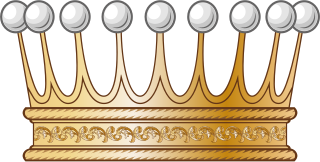
Graf is a historical title of the German nobility and later also of the Russian nobility, usually translated as "count". Considered to be intermediate among noble ranks, the title is often treated as equivalent to the British title of "earl".
Frederick III may refer to:

Hermann I, Landgrave of Thuringia and Count Palatine of Saxony, was the second son of Louis II, Landgrave of Thuringia, and Judith of Hohenstaufen, the sister of Emperor Frederick Barbarossa.

The German Emperor was the official title of the head of state and hereditary ruler of the German Empire. A specifically chosen term, it was introduced with the 1 January 1871 constitution and lasted until the official abdication of Wilhelm II on 9 November 1918. The Holy Roman Emperor is sometimes also called "German Emperor" when the historical context is clear, as derived from the Holy Roman Empire's official name of "Holy Roman Empire of the German Nation" from 1512.

The House of Schwarzburg was one of the oldest noble families of Thuringia, which is in modern-day central Germany. Upon the death of Prince Friedrich Günther in 1971, a claim to the headship of the house passed under Semi-Salic primogeniture to his elder sister, Princess Marie Antoinette of Schwarzburg who married Friedrich Magnus V, Count of Solms-Wildenfels. Reigning over the County of Schwarzburg and founded by Sizzo I of Schwarzburg, the family split in the 16th century into the lines of Schwarzburg-Sondershausen and Schwarzburg-Rudolstadt, with the Sondershausen dying out in 1909.
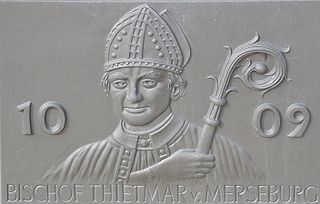
Thietmar, Prince-Bishop of Merseburg from 1009 until his death in 1018, was an important chronicler recording the reigns of German kings and Holy Roman Emperors of the Ottonian (Saxon) dynasty. Two of Thietmar's great-grandfathers, both referred to as Liuthar, were the Saxon nobles Lothar II, Count of Stade, and Lothar I, Count of Walbeck. They were both killed fighting the Slavs at the Battle of Lenzen.
Frederick II was the margrave of Meissen from 1323 until his death.

Henry III, called Henry the Illustrious from the House of Wettin was Margrave of Meissen and last Margrave of Lusatia from 1221 until his death; from 1242 also Landgrave of Thuringia.
Friedrich I of Nuremberg, the first Burgrave of Nuremberg from the House of Hohenzollern. He was the younger son of Count Friedrich II of Zollern, and became Count of Zollern as Friedrich III after the death of his other male relatives.
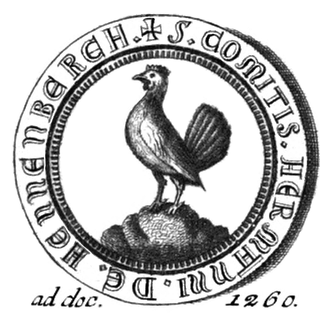
Herman I, Count of Henneberg was the son of Count Poppo VII of Henneberg and his wife, Jutta of Thuringia, the eldest daughter of Landgrave Herman I of Thuringia. This was Poppo's second marriage and also Jutta's second marriage. Margrave Henry III of Meissen was Herman's half-brother from his mother's side. Herman supported the election of his uncle Henry Raspe as anti-king of the Germans.
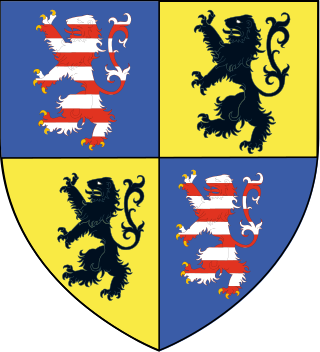
Frederick IV, nicknamed the Peaceful or the Simple, was a member of the House of Wettin and Margrave of Meissen who ruled as the last independent Landgrave of Thuringia from 1406 until his death.

Count Henry II of Nassau-Siegen, German: Heinrich II. Graf von Nassau-Siegen, official titles: Graf zu Nassau, Vianden und Diez, Herr zu Breda, was since 1442 Count of Nassau-Siegen, of Vianden and of half Diez. He descended from the Ottonian Line of the House of Nassau.

Ludwig II, Landgrave of Thuringia, nicknamed Louis the Iron.
Kunigunde of Eisenberg, was a German noblewoman and the second wife of Landgrave Albert II of Thuringia.

Louis III, nicknamed Louis the Pious or Louis the Mild was a member of the Ludowingians dynasty who ruled as Landgrave of Thuringia from 1172 until his death.
The following is a timeline of the history of the city of Erfurt, Germany.
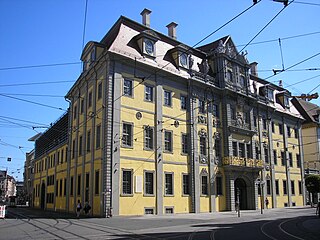
The Angermuseum is an art museum in Erfurt opened on 27 June 1886.

The 1125 German royal election was the Imperial election which lasted from 24 August to 1 or 2 September 1125, following the death of Henry V. It resulted in the coronation of the Duke of Saxony Lothair of Supplinburg as the King of the Romans by the Archbishop of Mainz, Adalbert on 13 September in Aachen.














